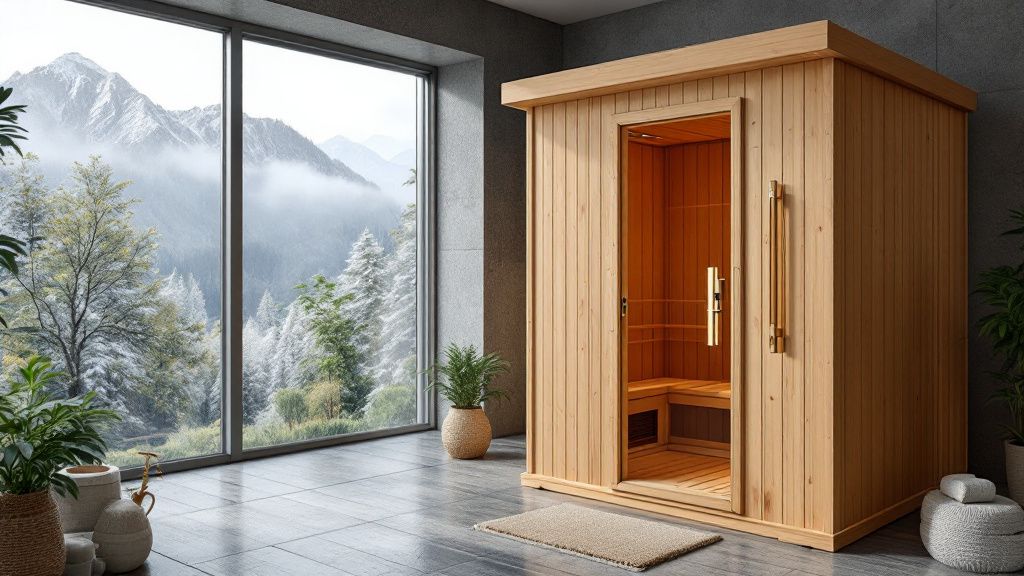Key Takeaways
- Steam saunas create a humid environment, ideal for skin care and respiratory relief.
- Dry saunas provide a hot, dry atmosphere, promoting detoxification and muscle relaxation.
- The choice between steam and dry saunas depends on personal wellness goals and preferences.
- Portable steam saunas offer convenience and flexibility for at-home use.
- Saunas support overall health but are not a standalone solution for weight loss.
In a steam sauna, the air is heavily saturated with moisture, creating a dense, humid environment that envelopes you in heat through steam production. This environment fosters relaxation as it opens up your pores and aids in detoxification, making the experience somewhat akin to sitting in a tropical mist. On the other hand, a dry sauna channels heat through dry air, typically sourced from a wood-burning stove or electrical heater, offering a less humid yet intensely warm atmosphere. This heat penetration can enhance circulation and provide cardiovascular benefits. While a portable steam sauna often offers this wet experience in a convenient, on-the-go format, the timeless appeal of a dry sauna lies in its traditional, purifying warmth. Both options, though different in humidity and heat method, present unique sauna benefits for relaxation and wellness.

Understanding Sauna Basics
Have you ever wondered how the basic elements of a sauna impact relaxation and wellness? At its core, a sauna is a room designed to offer therapeutic heat sessions. These heat sessions are known to enhance circulation, promote relaxation, and offer various health benefits by increasing body temperature and inducing sweating. The atmosphere within a sauna can significantly vary depending on whether it's a steam or dry sauna.
Saunas are typically heated using various sources like wood stoves, electric heaters, or steam generators. A dry sauna relies on such heat sources to create a hot, dry environment, whereas a steam sauna uses a consistent infusion of steam to generate heat and increase humidity. The differing levels of humidity between the two types lend themselves to unique experiences and benefits.
In a dry sauna, the higher temperatures and lower humidity can deeply penetrate your skin, promoting intense sweating and aiding in detoxification. This makes a dry sauna a compelling choice for those seeking to boost their cardiovascular system or engage in post-exercise recovery. Many prefer dry saunas because they offer a soothing, therapeutic warmth without the heaviness of moisture.
On the other hand, a steam sauna, including a portable steam sauna, surrounds you with humidity, creating a gentler and more moist experience. The high moisture content softens your skin and sinuses, helping alleviate tension. This type of sauna experience may be particularly beneficial for individuals looking to ease respiratory issues or simply enjoy a more enveloping heat experience.
Whether you step into a steam sauna or a dry sauna, each provides distinct sauna benefits tailored to your individual needs. Understanding these basics helps you make informed choices about which sauna experience best suits your wellness goals.
Exploring Steam Saunas
Steam saunas envelop you in a warm cloud of moist heat, providing a unique spa-like experience that stands apart from their dry counterparts. The elevated humidity can reach up to 100%, making the surrounding temperature feel hotter and promoting the opening of your skin’s pores. This humid environment not only assists in skin rejuvenation but also supports improved circulation by dilating your blood vessels.
Innovatively seen through the lens of portability, portable steam saunas allow you to enjoy these benefits at home or even on the go. Compact and easy to set up, these models offer a flexible solution for experiencing the soothing effects of steam saunas right in the comfort of your own space. Portable sauna tents can become a convenient wellness tool, merging the therapeutic aspects of a traditional spa with modern adaptability.
The sauna benefits of regular steam sessions include enhanced skin care by loosening impurities and easing muscle tension. For individuals with respiratory concerns, steam aids in clearing the nasal passages and improving overall breathing comfort. This makes steam saunas a compelling option for those seeking a comprehensive approach to relaxation and health improvement.

An Insight Into Dry Saunas
Dry saunas offer a distinct thermal experience through their use of heated air, providing an oasis of dry warmth that distinguishes them from their steam counterparts. Typically heated with wood-burning stoves or electric heaters, dry saunas foster an intensely warm environment with low humidity levels. This lack of moisture intensifies the heat, making it effective for inducing sweat and promoting detoxification through the pores. You might find it particularly beneficial for enhancing cardiovascular health and post-workout recovery.
Tracing its evolution from ancient Finnish traditions, the concept of dry saunas has a rich historical context. The Finns developed the sauna as a social and health-centric activity, valuing it as a space for physical cleansing and community gatherings. Even today, dry saunas retain this cultural heritage, often being a place where relaxation meets social interaction. As much a tradition as it is a health practice, the dry sauna exemplifies the balance between age-old customs and modern wellness benefits. Through consistent dry sauna use, you can experience reduced tension, improved circulatory function, and enhanced skin health.

Comparing Steam and Dry Saunas
When comparing steam and dry saunas, you step into two distinct worlds of heat therapy where moisture and temperature play pivotal roles. In a steam sauna, the presence of high humidity creates a warm, misty atmosphere that promotes respiratory benefits and provides a gentle skin-cleansing experience. The dense moisture in the air helps in softening the skin and easing tension, enhancing the overall sauna benefits.
In contrast, a dry sauna operates with minimal humidity, offering a hotter, drier environment that can penetrate deeply into your skin. This setting is optimal for those looking to intensify detoxification and boost circulation. A dry sauna is often favored for its simple and traditional heating approach, relying on high temperatures to eliminate toxins through perspiration without the aid of moisture.
The current state of sauna preferences shows a noticeable trend towards personalized wellness, where individuals seek tailored options like portable steam saunas for convenience and flexibility. This trend indicates a growing appreciation for the unique benefits each type of sauna provides, with users often choosing based on personal health goals and comfort preferences rather than a one-size-fits-all solution.

Common Misconceptions about Saunas
The world of saunas is often clouded with misconceptions, and you might wonder how they compare to common myths. For instance, some believe saunas cause extreme dehydration due to excessive sweating, but when used appropriately, they can be a controlled and beneficial hydrating process. It's essential to stay well-hydrated before and after your session to maximize the sauna benefits without adverse effects.
A prevalent misconception suggests that steam and dry saunas provide the same experience, yet the difference lies in their humidity levels. A steam sauna envelops you in a humid atmosphere, making it ideal for respiratory relief, while a dry sauna offers a hot, dry experience targeting deep muscle relaxation and detoxification. Each type caters to different wellness goals, highlighting the importance of choosing based on personal needs.
Comparing the notion of instant weight loss through saunas versus actual health improvement reveals yet another common misunderstanding. While saunas can induce temporary water weight loss, they don't replace healthy lifestyle habits needed for sustainable weight management. Regular sessions in either a dry sauna or a portable steam sauna should be part of a broader approach to health, rather than a sole weight loss method.
Frequently Asked Questions
What is the main difference between steam and dry saunas?
The primary difference is humidity; steam saunas have high humidity, while dry saunas have low humidity with intense heat.
Are dry saunas more beneficial than steam saunas?
Both offer unique benefits, with dry saunas enhancing circulation and detoxification, and steam saunas aiding in skin care and respiratory relief.
Can I use a portable steam sauna at home?
Yes, portable steam saunas are designed for home use and provide the same humid experience in a compact format.
Do saunas help with weight loss?
Saunas can promote temporary water weight loss but are not effective for long-term weight management.
Which sauna is better for relaxation?
Both steam and dry saunas offer relaxation benefits; the best choice depends on personal preference for humidity and heat experience.

